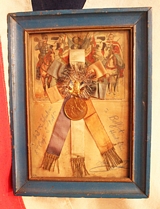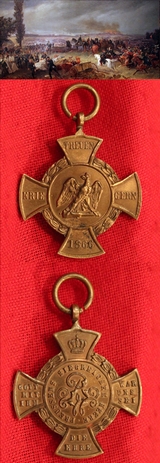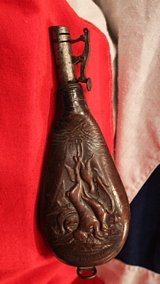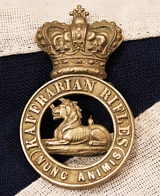Antique Arms & Militaria
British Pre- 1881 XCII 92nd Gordon Highlanders Uniform Cross Belt Badge
Plate (copper lugs) Order of the Thistle Star base with each arm of the saltire bearing three of the regiment?s battle honours, "XCII" to the centre within a thistle wreath surmounted by a crown resting on a scroll inscribed ?Highlanders?, lower section of the star bearing the sphinx on a blank tablet, very crisp detail, 71.3 mm x 95 mm, intact lugs, contact marks and light wear, very fine. read more
175.00 GBP
Souvenir de la Revision Classe 1905, 42nd Infantrie 8th Co. 2nd Bn
Republic Francais framed medallion with rosette and print of cavalry. Translation; Remembrance of Class 1905 revision. 42nd Infantry Regiment (42e r?giment d?infanterie or 42e RI) was an infantry regiment of the French Army, raised in 1635 as the 'R?giment de Calvisson'. It was renamed the 1638 : 'R?giment de Montpezat' in 1638 and the 'R?giment du Limousin' in 1684, before first gaining its numeral of 42 in 1791. During the First World War it was nicknamed the 'As de Carreau', since it was part of the 'Division des As' (a nickname for 14th Infantry Division). read more
75.00 GBP
A Fine Prussian Military Honour Medal In Silver 1814.
A large silver medal on its original silk ribbon. King Fredrick William III's Ehrenzeichen (honour medal). The inscription "VERDIENST UM DEN STAAT" (Meritorious Service to the State) which appears in the centre of the medal surrounded by a circular wreath of laurel leaves remained unchanged from its inception in 1814 until 1918. To better appreciate the reason why this particular decoration survived virtually unchanged as a continuous service award for subsequent Prussian kings and German Emperors after Friedrich Wilhelm III's death in 1840, to even include the retention of his initials, it may be helpful to understand the historical importance and context of his rule to the eventual founding of the German Empire.
In furtherance to this, King Frederick William III (1770-1840) succeeded to the throne of Prussia in 1797, at the age of 27, during the French Revolution. Fearful of the possible spread of democratic concepts to Prussia, he attempted to maintain a policy of strict neutrality in the political and military conflicts which were constantly taking place at that time between the new French republic and her bitter enemies in the long standing monarchies of Austria and England. Medal 1.5 inch across. Silver weight 25 grams approx. read more
110.00 GBP
Volunteer Artillery Busby Plume Holder Badge circa 1860 to 1873.
Other ranks nickel badge with slide to the reverse. Following the Crimean War, it was painfully clear to the War Office that, with half of the British Army dispositioned around the Empire on garrison duty, it had insufficient forces available to quickly compose and despatch an effective expeditionary force to a new area of conflict, unless it was to reduce the British Isles' own defences. During the Crimean War, the War Office had been forced to send militia and yeomanry to make up the shortfall of soldiers in the Regular Army. The situation had been complicated by the fact that both auxiliary forces were under the control of the Home Office until 1855.
Tensions rose between the United Kingdom and France following the Orsini affair, an assassination attempt on Emperor Napoleon III on 14 January 1858. It emerged that the would-be assassin, Felice Orsini had travelled to England to have the bombs used in the attack manufactured in Birmingham. The perceived threat of invasion by the much larger French Army was such that, even without sending a third of the army to another Crimea, Britain's military defences had already been stretched invitingly thin. On 29 April 1859 war broke out between France and the Austrian Empire (the Second Italian War of Independence), and there were fears that Britain might be caught up in a wider European conflict read more
110.00 GBP
The Prussian v Austria War Medal 1866, Made From Captured Cannon
Bronze cross patt?e alis?e, a laurel wreath between the arms, with ribbed loop for ribbon suspension; the face with a circular central medallion bearing the cipher ?WR? for King Wilhelm I, circumscribed ?PREUSSENS SIEGREICHEM HEERE? (Prussia?s victorious armies), the Prussian crown on the upper arm of the cross, the left, right and lower arms inscribed ?GOTT WAR MIT UNS. IHM SEI DIE EHRE? (God was with us. To Him be the glory); the reverse with a circular central medallion bearing the crowned Prussian royal eagle perched on a cannon, the upper, left, right and lower arms inscribed ?TREUEN?, KRIE-?, ?GERN?, ?1866? respectively; some slight age oxidisation and wear to gilding; on replaced correct ribbon. The medal was instituted by King Wilhelm I on 20 September 1866 following the victorious war against Austria and its German allies. The medal was cast from the bronze of captured Austrian cannon. The Austro-Prussian War or Seven Weeks' War (also known as the Unification War, Prussian?German War, German Civil War, War of 1866, as well as Brothers War or Fraternal War, and in Germany as German War) was a war fought in 1866 between the German Confederation ("Deutscher Bund") under the leadership of the Austrian Empire ("Kaisertum ?sterreich") and its German allies on one side and the Kingdom of Prussia with its German allies and Italy on the other, that resulted in Prussian dominance over the German states. In the Italian unification process, this is called the Third Independence War.
The major result of the war was a shift in power among the German states away from Austrian and towards Prussian hegemony, and impetus towards the unification of all of the northern German states in a Kleindeutsches Reich that excluded the German Austria. It saw the abolition of the German Confederation and its partial replacement by a North German Confederation ("Norddeutscher Bund") that excluded Austria and the other South German states. The war also resulted in the Italian annexation of the Austrian province of Venetia. read more
85.00 GBP
Prussian Danish War Medal, 1864, Made From Captured Guns
Prussian, Denmark Campaign Medal. 1864 - Engraved Edge. Since the London accords of 1852 the duchies of Schleswig, Holstein and Lauenburg were attached by personal union to Denmark. Following the new constitution of 1863 Denmark integrated these areas into the state which caused a protest from the Deutsche Bund. After a resolution of the German Bundestag the German states send "Execution" troops into the duchies which belonged to the German Federation (Holstein and Lauenburg) under the command of Generalleutnant Heinrich von Hake formed by a Saxon brigade under Generalmajor von Schimpff as the operational-force, a Hanoverian brigade under Generalleutnant Gebser as a supporting force and a Prussian and an Austrian brigade in reserve. The Austrians took part in this Bundesexekutionscorps by sending a brigade under the command of Generalmajor Leopold Graf Gondrecourt. But in addition to this, the two German major powers, Prussia and Austria, decided to declare war on Denmark and sent an army consisting of three corps under the command of the Prussian Feldmarschall Friedrich Graf Wrangel, whose Chief of the General staff was Generalleutnant Eduard Vogel von Falkenstein. The 1st corps was commanded by the Prussian Prince Friedrich Karl, the 2nd corps by Feldmarschall-Leutnant Ludwig Freiherr von Gablenz and the 3rd corps by Generalleutnant von der M?lbe. The 2nd (Austrian) corps was formed by the 6th army corps, enlarged by a cavalry brigade and 2 heavy batteries. Additionally Graf Gondrecourt's brigade also joined the 2nd corps after leaving the surprised federal troops. On the 1st of February 1864 58,000 Prussian and 21.000 Austrian soldiers crossed the Eider and commenced operations against the Danish land forces. On the 2nd and 6th of February the Austrians were victorious at Vejle and Oeversee whilst the Prussians were successful at the D?ppeler Schanzen near Sondersburg on the 18th of April 1864. On the 9th of May a naval squadron commanded by Contre-Admiral Wilhelm von Tegetthoff successfully engaged superior Danish forces near the island of Helgoland. The Danish forces retreated to Northern J?tland and the islands of Alsen and F?nen and an armistice for 6 weeks was agreed for a new peace treaty of London. After the failure of these negotiations the hostilities again resumed on the 25th of June 1864 and the Austrian forces reached the Northern part of J?tland and finally Cape Skagen. The Danish Captain Hammer, who had caused the most trouble for the Austro-Prussian naval forces was captured between the islands of F?hr and Sylt and a new armistice was implemented on the 20th of July 1864 which finally lead to the peace agreement of Vienna on the 30th of October 1864. Denmark was forced to hand over the contested duchies to Prussia and Austria. However disagreement over the administration of these duchies soon became one of the primary reasons, especially promoted by the Prussian prime minister Otto von Bismarck, for the coming conflict between the two German major powers in the war of 1866. Franz Joseph I, Kaiser of Austria, and Wilhelm I, King of Prussia, agreed to institute a commemorative medal for their successful army. The great number of captured guns, especially from the fortress of Frederica, made it possible to decide that the medals should be minted from the brass of the enemy's guns. Kaiser Franz Joseph signed the institution of the medal on the 10th of November 1864 and the regulations (Statuten) dated the 11th of November and both were published in the Armeeverordnungsblatt on the 20th of November 1864. The official name was: "Erinnerungs-Medaille an den Feldzug 1864 gegen D?nemark" (commemorative medal for the 1864 campaign against Denmark) Along the rim of the medal the words: "AUS EROBERTEM GESCHUETZ" (from captured guns) read more
85.00 GBP
A 19th Century Leather Shot Flask By Renown Maker James Dixon and Son
Embossed leather relief design of hanging game. J Dixon & Sons (James Dixon & Sons) founded 1806 in Sheffield, was one of the major British manufacturers in the Industrial Revolution of the 19th century. They were well known as manufacturers of Pewterware, Electroplated Britannia metal Silverware and Electroplated nickel silver. Their products included hundreds of items for use in the kitchen (e.g. bowls, cutting-tools) and the dining room(e.g. tea services, cocktail shakers and mixers) as well as items like candlesticks for all rooms. They were a world leader in manufacturing shooting accessories through nineteenth century and exported powder flasks in large quantities to America, They were known as whistle makers, which like most of their products were of outstanding quality; they were one of the 4 great whistle makers, the others being W Dowler & Sons, J Stevens & Son & T Yates.
It was located first at Silver Street (1806), Cornish Place (1822) Sheffield . They were also famous for their sporting trophies. Two of the most well-known are the Hales Trophy commissioned in 1932 (sometimes called the Blue Riband) though this really refers to the pendant flown by the sailing ship currently holding the record for the fastest crossing of the Atlantic. The trophy was then held by the owners of that ship. The other great trophy is the one presented to the winner of the American Masters Golf tournament held annually in Augusta Georgia. This trophy is a scale model of the clubhouse made in 1959-60 and contains 453 troy ounces of silver. read more
120.00 GBP
George Vth 13th County of London Kensington Helmet Plate
Excellent condition. It was first formed in 1908 in order to regiment the 26 Volunteer Force battalions in the newly formed County of London, each battalion having a distinctive uniform.
Now part of the Territorial Force, the London Regiment expanded to 88 battalions in the First World War. Of these 49 battalions saw action in France and Flanders, 6 saw action at the Gallipoli Campaign, 12 saw action at Salonika, 14 saw action against the Turks in Palestine, and one saw action in Waziristan and Afghanistan.
The London Regiment ceased to exist in 1938 and the battalions transferred to regular infantry regiments, the Royal Artillery and the Royal Engineers. read more
165.00 GBP
A Very Fine East Yorkshire Regt. Officer's Cap badge
In gilt silver and enamel . Two fixing lugs. Raised in 1685 in Nottingham by Sir William Clifton, 3rd Baronet, it was originally, like many British infantry regiments, known by the name of its current Colonel. In 1751, when the numerical system of designation of Regiments of Foot was adopted, it became the 15th Regiment of Foot and in 1782 the 15th (The Yorkshire East Riding) Regiment of Foot. With the Childers Reforms of 1881, it became The East Yorkshire Regiment, the County Regiment of the East Riding of Yorkshire, and in 1935 was renamed The East Yorkshire Regiment (The Duke of York's Own), after its Colonel-in-Chief. In 1958, it was amalgamated with The West Yorkshire Regiment (The Prince of Wales's Own), to form The Prince of Wales's Own Regiment of Yorkshire.
It fought in the War of Spanish Succession, the Jacobite Rising of 1719 and in North America and the West Indies during the War of Jenkin's Ear, Seven Years' War and the American Revolutionary War including battles such as Capture of St. Lucia in 1778. It again fought in the West Indies during the Napoleonic Wars, taking part in the invasions of Martinique (1809) and Guadeloupe (1810).
The regiment spent most of the 19th century on garrison duty, both at home and throughout the Empire. The 1st Battalion was shipped to New Brunswick in 1862 at the time of the "Trent Affair", when Britain and the United States of America came close to war. The 2nd Battalion fought in the Second Anglo-Afghan War and the Second Boer War. Battle honours
Regimental colours; Blenheim, Ramillies, Oudenarde, Malplaquet, Louisburg, Quebec 1759, Martinique 1762, Havannah, St. Lucia 1778, Martinique 1794 1809, Guadeloupe 1810, Afghanistan 1879-80, South Africa 1900-02, The Great War (21 battalions): Aisne 1914 '18, Armenti?res 1914, Ypres 1915 '17 '18, Gravenstafel, St. Julien, Frezenberg, Bellewaarde, Hooge 1915, Loos, Somme 1916 '18, Albert 1916 '18, Bazentin, Delville Wood, Pozi?res, Flers-Courcelette, Morval, Thiepval, Ancre Heights, Ancre 1916, Arras 1917 '18, Scarpe 1917 '18, Arleux, Oppy, Messines 1917 '18, Pilckem, Langemarck 1917, Menin Road, Polygon Wood, Broodseinde, Poelcappelle, Passchendaele, Cambrai 1917 '18, St. Quentin, Bapaume 1918, Rosi?res, Lys, Estaires, Hazebrouck, Kemmel, Scherpenberg, Amiens, Hindenburg Line, ?p?hy, Canal du Nord, St. Quentin Canal, Selle, Sambre, France and Flanders 1914-18, Struma, Doiran 1917, Macedonia 1915-18, Suvla, Landing at Suvla, Scimitar Hill, Gallipoli 1915, Egypt 1915-16
The Second World War: Withdrawal to Escaut, Defence of Escaut, Defence of Arras, French Frontier 1940, Ypres-Comines Canal, Dunkirk 1940, Normandy Landing, Tilly sur Seulles, Odon, Caen, Bourgu?bus Ridge, Troarn, Mont Pincon, St. Pierre la Vielle, Gheel, Nederrijn, Aam, Venraij, Rhineland, Schaddenhof, Brinkum, Bremen, North-West Europe 1940 '44-45, Gazala, Mersa Matruh, Defence of Alamein Line, El Alamein, Mareth, Wadi Zigzaou, Akarit, North Africa 1942-43, Primosole Bridge, Sicily 1943, Sittang 1945, Burma 1945 read more
95.00 GBP
A Victorian Kaffrarian Rifles Badge, of South Africa, Motto "Nunc animus"
Nunc animus (meaning "Now with courage" or "Now without fear") This unit was formed in East London in 1876, as the Buffalo Corps of Rifle Volunteers, for service in the 9th Frontier War. It disbanded in 1879. (East London is situated on the Buffalo River, hence the name).
The unit was re-formed in July 1883 and was named after the region of Kaffraria, the 19th-century name for the region around East London. There had previously been many other units from this region, from which the Regiment can also claim descent: Kaffrarian Volunteer Corps, Kaffrarian Mounted Rifles (Kaffrarian Rangers), Buffalo Volunteer Rifles Corps, Buffalo Volunteer Engineers, Kaffrarian Volunteer Artillery Corps, Berlin Mounted Volunteers, Cape Mounted Yeomanry (1st Regiment), Frontier Mounted Riflemen (Brabant's Horse), East London Volunteers (Von Linsignen's Buffalo Corps and later Walkers Horse).
On 1 December 1900 George Herbert Farrar was appointed as a Major in the Kaffrarian Rifles.
In 1913 it was embodied in the Citizen Force as the 5th Infantry (Kaffrarian Rifles), but regained its old name in 1932. The unit was temporarily amalgamated with the First City Regiment, as the First City/The Kaffrarian Rifles from 1954 to 1956. In order to keep pace with the changing political climate in South Africa, the regiment was renamed the Buffalo Volunteer Rifles in 1999.
This Regiment and its predecessors took part in all of South Africa's armed conflicts, including the Bechuanaland Campaign (1897), the Second Boer War, World War I (when it fought in the then German South-West Africa and most of its members went on to serve in East Africa and Europe), World War II (when it fought in the Western Desert during 1941 - 1943 . 62 mm high read more
95.00 GBP











